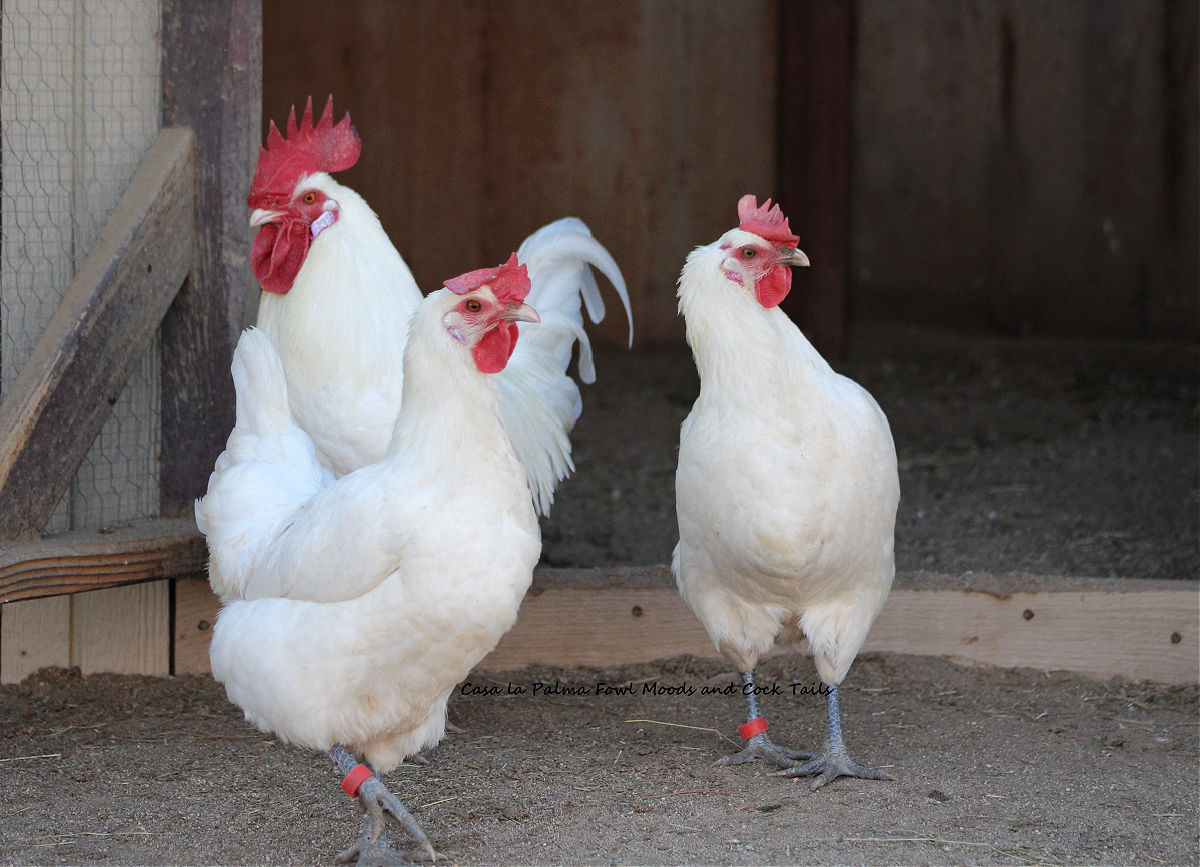Yellowing in White American Bresse
Yellowing in White American Bresse Chickens: The how and why of yellowing in white feathers. Understand the underlying genetics of feather yellowing, and discover how to minimize or eliminate this unwanted trait.
It is very likely that you've seen them in your own flock - that bold and beautiful white American Bresse rooster whose feathers begin to yellow as it approaches adulthood. Or maybe the yellowing sets in after that first adult molt. You may see it around the wings, hackles, and/or sickle feathers.
Yellowing in the feathers of White American Bresse is common, and it is common in French Bresse flocks as well, but it is actually considered an unwanted trait. To learn how to eliminate the problem, one needs to become at least a little familiar with chicken color genetics.
I'm not a chicken geneticist; but Mr. Kerby Jackson has studied chicken genetics for many years, and he graciously allowed me to present his explanations on the Ambresse website. It is a very interesting read!
Yellowing in White American Bresse Chickens
By Kerby Jackson
The Reason for Yellowing in White American Bresse Chickens
There are two "ground colors" in poultry. The first is Eumelanin: eumelanin is basically responsible for the black areas of plumage.
The second is Pheomelanin which is basically responsible for gold, silver and red areas of the plumage.
Numerous genetic factors have different effects on the presence and/or appearance of both. Poultry that are exclusively of a Pheomelanin ground color are quite rare. Most possess at least some Eumelanin.
The primary effect of the Dominant White factor is to suppress or bleach out Eumelanin. In this regard, it converts the black areas of a bird's plumage to white by eliminating the effect of the pigment.
When Dominant White is present only in a heterozygous form (Dominant White, plus a second gene of either recessive white, or black or other color), we get only a partial effect in that whole or partial feathers may be unaffected (hence the production of Bresse with a few black or variegated feathers).
When Dominant White is present in a homozygous state, its effect on Eumelanin is total and we get a solid white bird.
Dominant White's Effect on Pheomelanin
Here is where Dominant White gets more interesting.
Even though it totally effects Eumelanin, it has a lesser effect on Pheomelanin. Even in a homozygous state, it only softens, dilutes, or "washes out" the appearance of the Pheomelanin. So as a classic example, if we add Dominant White to a Golden Sebright, the gold base color is softened, while the black lacing is converted to white. This is true as well with Golden Campines, in that the Dominant White softens the gold bars and converts the black bars to white bars. In both cases, we get what is considered a Chamois.
Now the same thing happens in other "color varieties." So for example, in a Gold Ducking rooster, if we add Dominant White, it converts the black breast, wing bars and the tail from black to white. In a Golden Birchen hen with a black body and golden hackle, when we add Dominant White, it converts the hen's body to white, but it leaves the golden area in the hackle.
And that is ultimately a primary reason why we see yellowing in many Whites. Though the white can have a total effect on the Eumelanin areas of the bird, it has a much lesser effect on the Pheomelanin areas of the same bird.
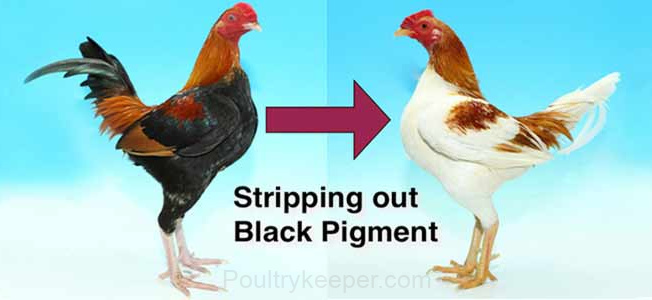 Photo Credit: Poultrykeeper.com.
Photo Credit: Poultrykeeper.com.Needless to say, the Pheomelanin has the effect of "leaking through," which can result in yellowing of various shades. What's more, inhibitor genes can also assist in this process and create a wide array of phenotypes and sometimes partially kind of turn off or further turn on Pheomelanin.
Dominant White's imperfect dominance over pheomelanin is the root cause of yellowing in white American Bresse chickens. The presence of modifying factors that augment, or diminish, the yellowing, along with the presence or absence of an underlying solid black primary color, will define how obviously the yellowing will present itself.
Yellowing in White American Bresse as a Breeding Problem
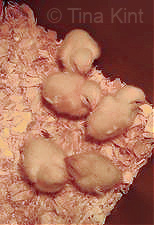 Photo credit: Tina Kint, used with permission.
Photo credit: Tina Kint, used with permission.Pictured: Week-old white American Bresse hatchery chicks. Most of these chicks are maturing into white birds, but see that smaller chick on the bottom right? Even in this very low-resolution photo, you can see a spot of black leakage along with grayer than usual yellow fluff. This chick has grown into the teenage pullet pictured below, with obvious yellowing and traits of black leakage.
Probably the best way to view yellowing as a breeding problem is from the view that the plumage color being covered over by the Dominant White is simply not whole colored. An entirely Black Bresse that is homozygous for Dominant White will appear pure white, while a Black Bresse with gold, silver or red areas on the body that is homozygous for Dominant White, will be white with yellowing in the gold or red areas and what could best be considered "graying" in areas that might be silver.
In an ideal world, if we want a bunch of pure white Bresse free of yellowing, we really want to build it on a pure black Eumelanin base as opposed to building on a base that is only partially or mostly effected by Eumelanin/Black.
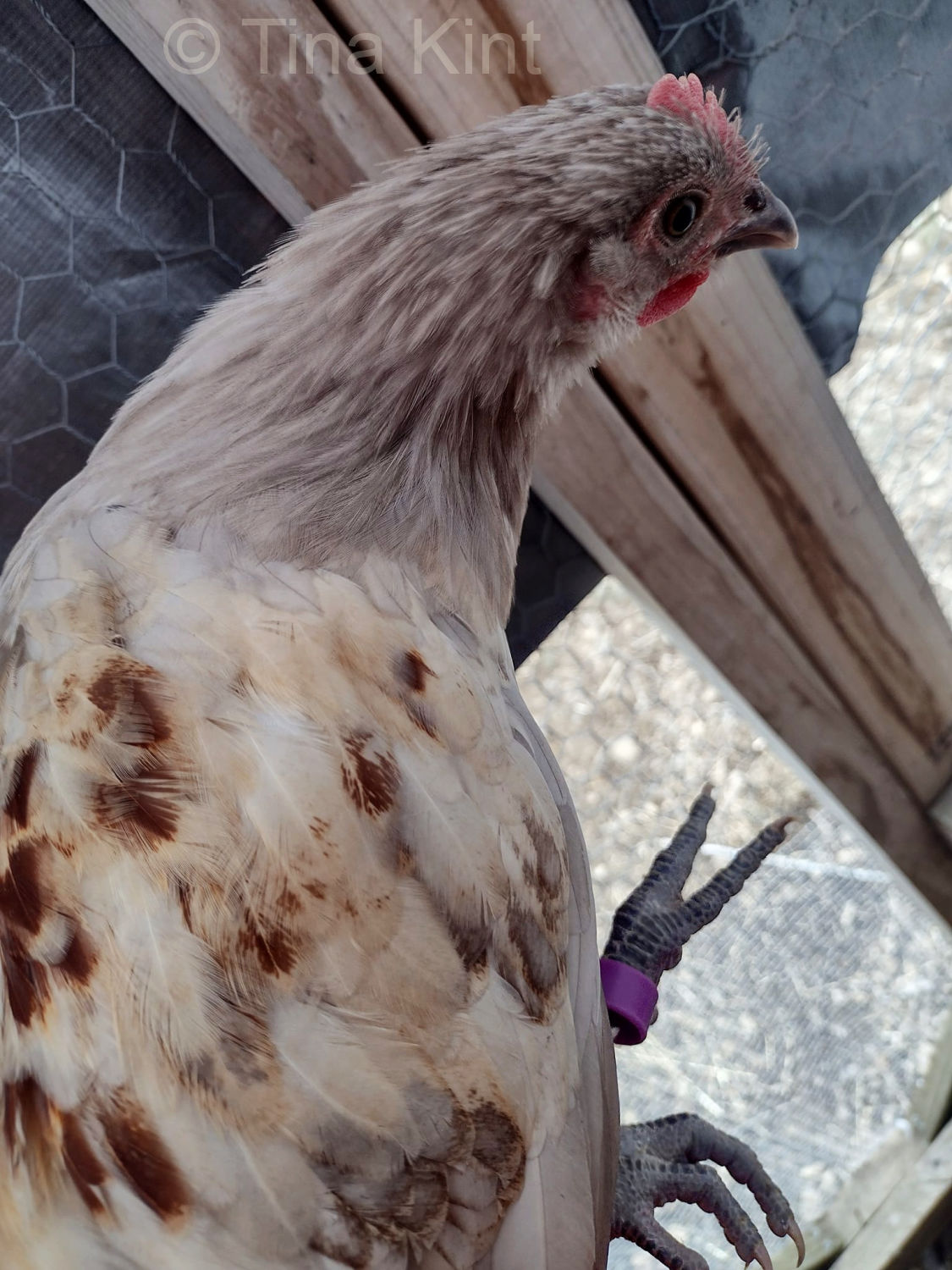 Young pullet with significant yellowing along with traits of black leakage. Photo credit: Tina Kint, used with permission.
Young pullet with significant yellowing along with traits of black leakage. Photo credit: Tina Kint, used with permission.In other words, we want a black color base, not black with a gold hackle or gold in the bows or saddle. Since it's said that the first White Bresse were actually produced from Silvers/Grays, you can see that the very genetic basis of most White Bresse was probably always subject to Pheomelanin trying to punch through the white, so it's probably been a longstanding problem.
I also think that one of the big problems is that a lot of Whites also have Blues in their background and a large number of Blue Bresse show rusty looking tinges in their hackles and elsewhere. Those rusty colored feathers will definitely come out as varying shades of yellow if Dominant White is added over top of it.
I should also add that among some of my project birds here, I have some birds that are "very yellow." One of them is a 3/4 Bresse 1/4 Brabanconne Red Plye male that shows very bright patches of yellow leakage. Another is a hen from my Chamois Campine project that is 1/2 Leghorn, 1/4 Golden Campine and 1/4 Golden Penciled Hamburg and she is actually a Dominant White that is so completely affected that she looks like she's been misted with yellow spray paint across the entirety of her body. I call her my "Yellow Bird" because it's the most extreme example of yellowing I've ever seen on a white. In both cases, this is a large amount of Pheomelanin punching through the white and being softened to a bright hue.
Note that yellowing in white American Bresse Chickens has no impact on carcass quality.
Yellowing in White American Bresse:
Minimizing or Eliminating Yellowing
Is it possible to minimize or eliminate the yellowing in white American Bresse caused by pheomelanin??
Yellowing will express randomly unless you purposely try to control it. One way to try to do that would be to outcross to Blacks which are completely free of any rusty, etc., coloration and then breed the F1 together. A small percentage of the F2 would be Whites overlaying homozygous Black. It would take some progeny testing to prove which are the right ones, but after you had a few, you would probably completely eliminate the chance of yellowing.
Or, you can just cull the existing whites like mad and "hope"....

You might also be interested in these genetic topics:
- Black Leakage in American Bresse, by Mr. Kerby Jackson
- White Genes in American Bresse, by Ms. Nancy Norwood
- American Bresse Genetic Questions
About Kerby Jackson
Kerby Jackson has been exploring chicken color genetics for over forty years. One of his pet projects has been resurrecting lost varieties of Campines. But additionally, he has been working on genetic projects involving American Bresse with Brabanconne Red Plye, and a triple-breed project utilizing Leghorns, Golden Campines, and Golden Penciled Hamburgs.
Kerby lives in Grants Pass, Oregon.
Kerby Jackson's Bio
Contact Info: See Kerby Jackson in OR
- Home
- ABC Genetics Questions
- Yellowing in White ABCs
Overheard...
Tasty Recipe! "I processed my first batch of Bresse... Today I roasted one according (somewhat) to the recipe posted on Ambresse. It was delicious! Tender, moist and succulent... So happy I chose this breed!" (B.E., MN, 12/11/2024).
Success: "I can't believe all the inquiries we get through your website. And it's been a great resource to send people to who are interested in the (AB) breed" (Utangard Farm, NH, 5/5/2025).
Informational: "Your site has the first accurate information about American Bresse chickens that I have seen in English. Thanks for your diligent work" (L. Wooton, NC, 12/17/2024).
Translate This Page
Traduire Cette Page
Traduzca Esta Pagina

News
American Bresse Breed Club web pages can be found under the Breed Club tab on the navigation bar. Any changes in Club status will be posted here!
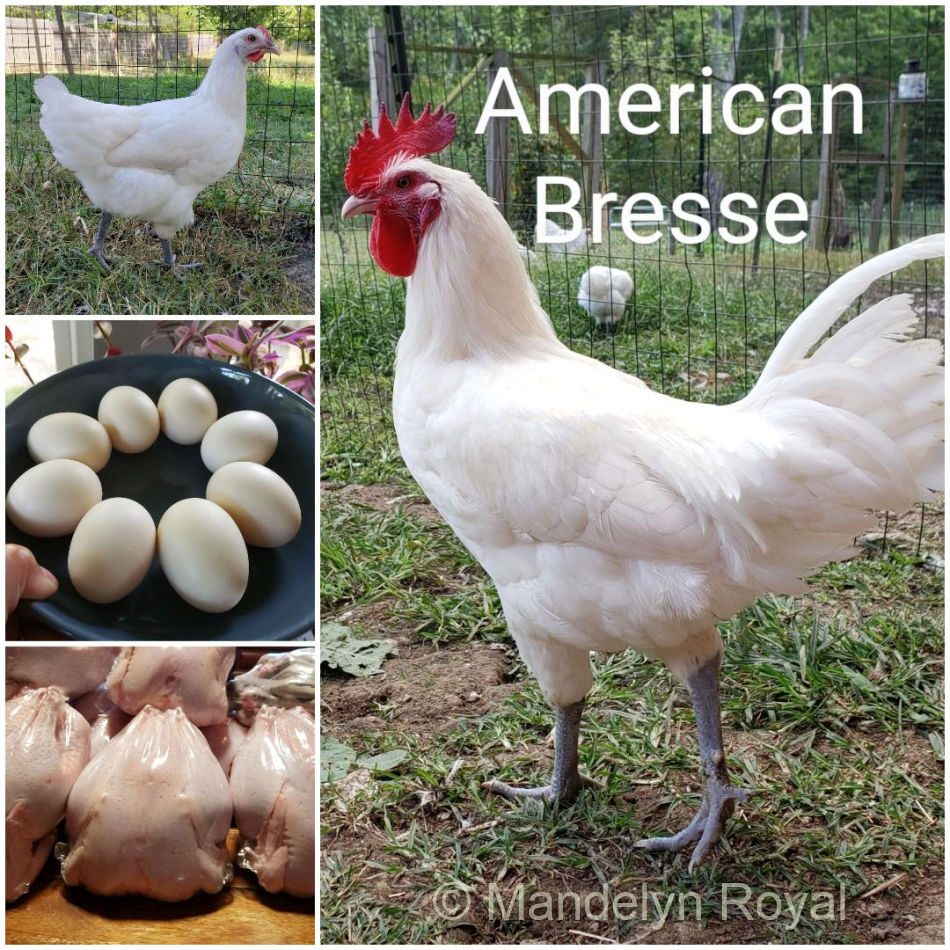
Photo credit: Mandelyn Royal.
